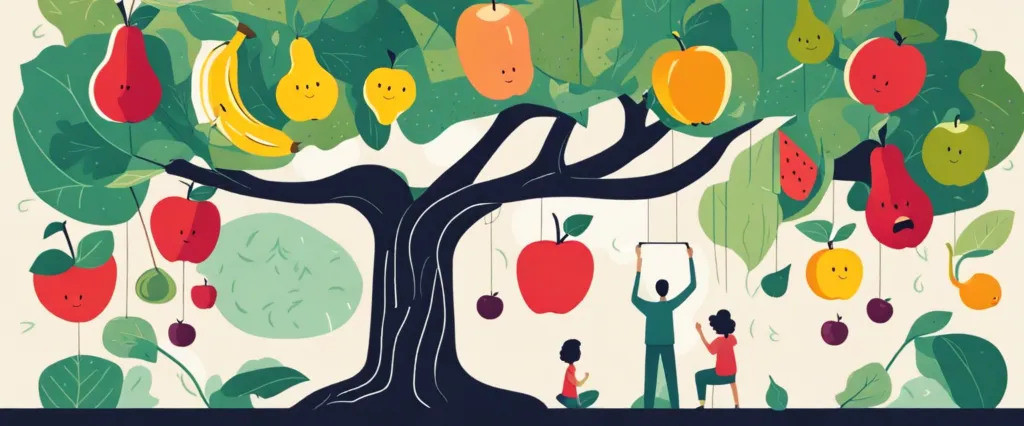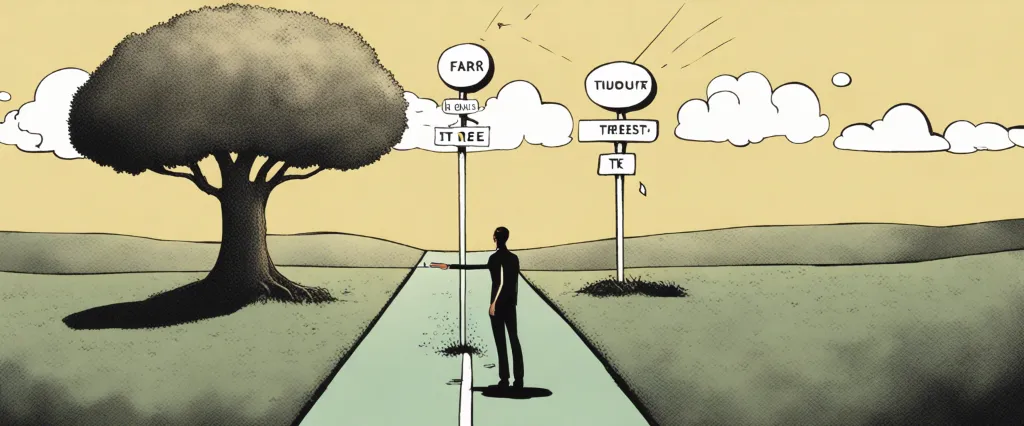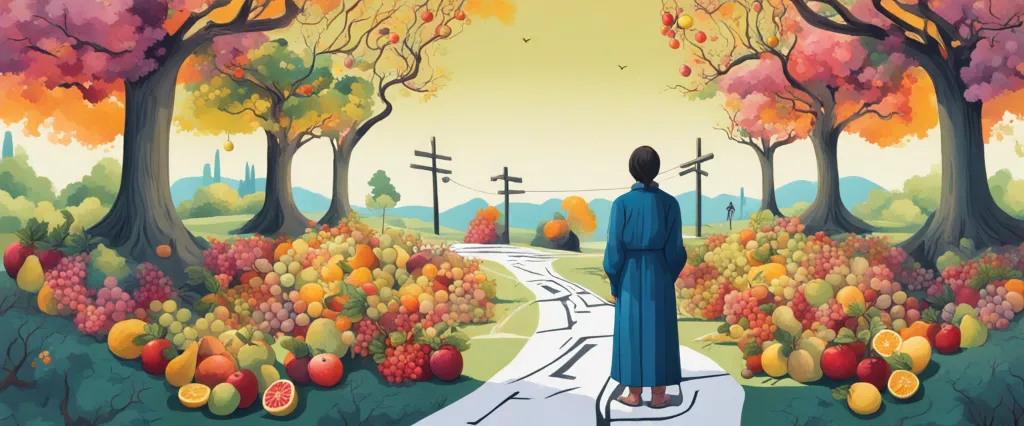In “Far from the Tree“, Andrew Solomon explores the intricate dynamics of love, acceptance, and family by delving into the lives of parents whose children are significantly different from them. In this groundbreaking book, Solomon examines a wide range of conditions, including deafness, Down syndrome, autism, and schizophrenia, among others, to understand how families navigate the challenges and triumphs that come with raising a child who diverges from societal norms. As an accomplished writer and scholar, Andrew Solomon brings a deeply personal perspective to his work, drawing not only from extensive research but also from his own experiences as a gay man and as a son seeking acceptance within his own family. With profound empathy and eloquence, Solomon’s exploration transcends the boundaries of individual identities, revealing the common humanity that binds us all.
Chapter 1: Son – Exploring the experiences of parents raising children with disabilities.
Chapter 1 of “Far from the Tree” by Andrew Solomon, titled “Son – Exploring the experiences of parents raising children with disabilities,” delves into the challenges and complexities faced by parents raising children with disabilities. Solomon shares his own personal journey as a gay man, which influences his understanding of what it means to have a child who diverges from society’s norms.
Solomon explores the experiences of families raising children with Down syndrome, autism, and other disabilities. He introduces us to the extraordinary resilience displayed by these parents and highlights the powerful love they have for their children. Through in-depth interviews, he captures the wide range of emotions parents go through, from the initial shock and grief to finding acceptance and building a fulfilling life for their child.
One of the key aspects that Solomon uncovers is the tension that arises between society’s expectation of “normalcy” and the reality of parenting a child with a disability. He challenges the notion that these children are lesser or broken, arguing instead that they have their own unique identities and ways of experiencing the world. He suggests that society needs to shift its focus from “fixing” these children to accepting and celebrating them as they are.
Throughout the chapter, Solomon emphasizes the importance of community and support networks for parents. He describes how connecting with other families navigating similar journeys can provide a sense of belonging and a source of knowledge and encouragement.
Overall, Chapter 1 of “Far from the Tree” provides an empathetic and thought-provoking exploration of the experiences of parents raising children with disabilities, highlighting the strength, love, and resilience they display in the face of adversity.
Chapter 2: Deaf – Examining the Deaf community and the challenges faced by deaf individuals.
Chapter 2 of “Far from the Tree” by Andrew Solomon focuses on the Deaf community and the specific challenges faced by deaf individuals. Solomon delves into the concept of Deaf culture, highlighting the distinction between deafness as a medical condition and deafness as a cultural identity.
The chapter explores the complex relationship between deaf individuals and the idea of hearing “normalcy.” Solomon investigates the experience of being Deaf in an overwhelmingly hearing-centric world, the prejudice faced by deaf people, and the modes of communication they employ.
The chapter starts by discussing the advances in technology that have challenged the Deaf community’s culture and emphasis on sign language. With the advent of cochlear implants, some deaf individuals have the option to gain functional hearing ability. This development raises questions about the preservation of Deaf culture and the potential erosion of a unique identity.
Solomon emphasizes the significance of sign language within the Deaf community, highlighting its expressive power and the sense of belonging it fosters. He explores the importance of Deaf schools in nurturing a distinct cultural identity and fostering a sense of community.
Moreover, the chapter investigates the experiences of deaf children and their families. It examines the challenges faced by parents in deciding whether to pursue cochlear implants for their children, thereby potentially “normalizing” them, or to embrace and support their Deaf identity.
Solomon analyzes the Deaf community’s desire for recognition and acceptance, advocating for a society that embraces deafness as a valid and diverse human experience. He delves into the complexities of understanding and appreciating the unique struggles and triumphs of the Deaf community.
In summary, Chapter 2 of “Far from the Tree” delves into the intricacies of Deaf culture, explores the challenges faced by deaf individuals, and aims to foster understanding and acceptance of the Deaf community within society.
Chapter 3: Dwarfs – Understanding the lives of individuals with dwarfism and their unique perspectives.
Chapter 3 of “Far from the Tree” by Andrew Solomon delves into the lives of individuals with dwarfism and explores the unique perspectives they have. Solomon begins by examining the medical and genetic aspects of dwarfism, emphasizing that it is not a disability, but rather a form of human diversity.
Solomon introduces us to various individuals with dwarfism who share their experiences and insights. He shows how their perspectives differ from those of average-sized people, particularly in relation to societal norms and expectations. These individuals often face challenges and discrimination that arise from their physical differences.
One key theme in this chapter is the impact of technology and medical advancements on the lives of people with dwarfism. While these advancements can bring medical benefits and improve quality of life, some individuals express concerns about the potential loss of a distinct culture and community if dwarfism is eradicated altogether.
Additionally, the chapter explores the importance of family support and acceptance in the lives of individuals with dwarfism. Many share stories of parents who encouraged them to embrace their differences and develop a strong sense of self. Solomon highlights the shared experiences among families with dwarf children through their support networks and organizations.
Overall, Chapter 3 sheds light on the distinctive perspectives and experiences of individuals with dwarfism. It encourages readers to challenge societal norms and prejudices, promoting a deeper understanding and acceptance of human diversity in all its forms.
Chapter 4: Down Syndrome – Exploring the joys and struggles of families with children with Down syndrome.

Chapter 4 of “Far From the Tree” by Andrew Solomon delves into the experiences of families with children who have Down syndrome. Solomon begins by discussing his own preconceived notions about the condition and how his research helped him better understand the complexities and diversity within the Down syndrome community.
The author emphasizes the importance of recognizing that Down syndrome is not a single experience but rather a collection of stories and challenges faced by families. He highlights the different ways parents react to receiving a diagnosis, ranging from devastation to acceptance and determination. Some parents seek early intervention programs to help their children reach their full potential, while others embrace a more laid-back approach, focusing on their child’s happiness rather than their academic achievements.
Solomon introduces us to several families who share their own journeys raising children with Down syndrome. These parents discuss the joys and struggles they have encountered, such as societal stereotypes, medical setbacks, and the need for ongoing support and advocacy. The author also explores the difficult decision some parents face when considering prenatal testing and the moral complexities it presents.
Throughout the chapter, Solomon challenges society’s notion of “normal” and urges readers to shift their perspective and embrace the diversity and uniqueness each individual with Down syndrome brings. He emphasizes the importance of love, acceptance, and understanding, and encourages society to create a more inclusive world where individuals with Down syndrome can thrive and contribute their unique gifts to society.
Overall, Chapter 4 of “Far From the Tree” provides a comprehensive and empathetic look into the lives of families with children who have Down syndrome. Solomon’s research and personal anecdotes shed light on the joys and struggles these families face, promoting a more inclusive and compassionate understanding of people with Down syndrome.
Chapter 5: Autism – Investigating the complexities of autism and its impact on families.
Chapter 5 of “Far from the Tree” by Andrew Solomon delves into the intricacies of autism and the profound effects it has on families. Solomon explores the personal stories of several families with autistic children, offering a multi-faceted understanding of the condition and its impact.
The chapter begins with a deep dive into the life of Jacob, a severely autistic boy who experiences significant sensory challenges, making ordinary activities immensely difficult for his family. The author emphasizes the immense devotion and love that Jacob’s parents have for their son, despite the immense challenges they face on a daily basis.
Solomon also examines the concept of neurodiversity, challenging the traditional view of autism as a mere disorder that needs to be “fixed.” He argues that individuals with autism possess unique abilities and perspectives that should be embraced by society, rather than simply treated as abnormalities.
Furthermore, the author explores the impact of autism on sibling relationships and the varying emotional responses that siblings have towards their autistic brothers or sisters. Solomon acknowledges the complexities that arise in these relationships, ranging from resentment to deep empathy and understanding.
Highlighting various therapeutic approaches and interventions for autism, Solomon presents a nuanced perspective on treatment options. He discusses the concept of “joining” individuals with autism rather than attempting to change them, as well as the value of alternative communication methods such as sign language and facilitated communication.
Overall, Chapter 5 of “Far from the Tree” provides a compassionate and thought-provoking exploration of autism and its profound impact on families. Through personal anecdotes and careful analysis, Solomon urges readers to view autism from a lens of acceptance, appreciation, and understanding.
Chapter 6: Schizophrenia – Delving into the experiences of individuals living with schizophrenia and their families.
Chapter 6 of “Far from the Tree” by Andrew Solomon delves into the experiences of individuals living with schizophrenia and their families. Solomon explores schizophrenia from various angles, sharing stories of those affected by the disorder and the challenges they face.
The chapter begins with Solomon recounting his interviews with several individuals diagnosed with schizophrenia. He highlights the most common symptoms, including hallucinations, delusions, disorganized thoughts, and social withdrawal. Solomon emphasizes that schizophrenia is not a single experience shared by all sufferers, as the severity and manifestation of symptoms can vary widely.
Solomon introduces us to Eliza, a young woman diagnosed with schizophrenia, who shares her struggles and achievements in coping with the illness. Eliza’s experiences reveal the complexity of living with schizophrenia, as she often battles against her own mind and the stigma associated with her condition. This stigma often leads to isolation, unemployment, and strained familial relationships.
The author goes on to discuss the impact of schizophrenia on families, shedding light on the emotional, financial, and social burdens they often face. Solomon interviews parents who have had to navigate through the maze of medications, therapy options, and hospitalizations in order to support their affected child. He illustrates how schizophrenia can disrupt family dynamics, leading to pressures and stress that consume households.
Throughout the chapter, Solomon aims to debunk misconceptions and challenge societal attitudes towards schizophrenia. He explores the progress made in understanding the disorder, as well as the potential for future advancements in treatment and support. By portraying the experiences of those affected by schizophrenia, the chapter encourages empathy and understanding, emphasizing the need for society to provide better resources and support systems for individuals and families dealing with this complex mental illness.
Chapter 7: Disability – Examining society’s perception of disability and the concept of “normalcy.”
In Chapter 7 of “Far from the Tree,” Andrew Solomon explores society’s perception of disability and the concept of “normalcy.” He presents the experiences of parents raising children with different disabilities, challenging the idea that disability is solely a deficiency or a deviation from an ideal standard.
Solomon discusses the historical context of disability, where individuals with disabilities were often segregated or institutionalized due to a view that they were abnormal and incapable of contributing to society. However, he highlights the transition toward an inclusive society that began in the late 20th century, emphasizing the importance of recognizing disability as part of human diversity.
The chapter delves into the concept of “normalcy” and how it relates to disability. Solomon argues that society’s perception of normality is merely a social construct, shaped by the majority. He explains that the ideal of normalcy creates a culture of exclusion and marginalization for those who deviate from it. By challenging this notion, he advocates for a more inclusive society that celebrates and accommodates a range of human experiences.
The author explores society’s tendency to view disability as a tragedy, leading to pity and otherizing people with disabilities. However, he presents interviews with individuals with disabilities who have embraced their identities and found strength within their communities. Solomon emphasizes the importance of accepting disability as a natural variation of the human condition, rather than pathologizing it.
In conclusion, Chapter 7 of “Far from the Tree” critiques society’s perception of disability and normalcy. Solomon urges readers to recognize that disabilities are diverse forms of human variation and calls for a shift toward an inclusive society that celebrates and empowers people with disabilities.

Chapter 8: Transcendence – Finding beauty and resilience in the face of adversity and celebrating diversity.
Chapter 8 of “Far from the Tree” by Andrew Solomon focuses on the concept of transcendence, particularly in finding beauty and resilience in the face of adversity and celebrating diversity. The chapter delves into the stories of individuals and communities who have embraced their differences and used them as a source of strength.
Solomon begins by highlighting the work of various artists with disabilities who have found ways to express their unique perspectives through their art. He explores how these individuals have turned their perceived limitations into sources of creativity and inspiration. Additionally, he discusses the role that faith and spirituality can play in providing solace and fostering resilience in times of hardship.
The chapter also explores the experiences of families who have come together to form supportive communities in the face of adversity. Solomon shares stories of parents who have children with severe disabilities or conditions, such as autism or Down syndrome. These families find solace and strength in connecting with others who understand their experiences, providing each other with valuable support, and celebrating their children’s uniqueness.
Furthermore, Solomon discusses the concept of “altered relationships,” which refers to the transformation that occurs within families when a child with a disability is born. He explores how families can navigate these changes and find love, acceptance, and a deeper sense of connection through embracing their child’s differences.
Overall, this chapter emphasizes the importance of embracing diversity and finding beauty in the face of adversity. It illustrates how individuals and communities can transcend societal expectations and norms to forge their own path, celebrating the unique perspectives and abilities that come with difference.
After Reading
Far from the Tree, written by Andrew Solomon, explores the intricacies and challenges of parenting children who are significantly different from their parents. This groundbreaking book provides a thought-provoking analysis of families navigating the complexities of raising children with various conditions, including autism, deafness, and schizophrenia. Solomon’s comprehensive research and extensive interviews shed light on the unique experiences of these families, revealing both the struggles they face and the resilience they possess. Ultimately, Far from the Tree emphasizes the importance of acceptance, empathy, and redefining conventional notions of what it means to be a family. It serves as a powerful reminder that despite their differences, love and connection can transcend any barriers.
1. “The Geography of Genius” by Eric Weiner: This captivating book explores the connection between location and genius, examining how certain places have historically fostered creativity and innovation. Weiner delves into the lives of renowned geniuses throughout history, examining what factors contributed to their unique achievements and how they overcame societal norms.
2. Quiet: The Power of Introverts in a World That Can’t Stop Talking” by Susan Cain: Like “Far from the Tree,” this book challenges societal norms and celebrates individual differences. Cain explores the value and underestimated power of introverts in a society that often favors extroverted personalities. With fascinating case studies and compelling research, she offers insights into how introverts can excel and contribute their unique voices to the world.
3. “The Empathy Exams” by Leslie Jamison: This thought-provoking collection of essays delves into the complexities of human connection, examining the power and limitations of empathy. Jamison explores a range of experiences, from her time working as a medical actor to personal reflections, inviting readers to consider the ways in which understanding and embracing difference can enrich our lives.
4. “The Spirit Catches You and You Fall Down” by Anne Fadiman: This compelling work of narrative nonfiction tells the true story of a Hmong child with epilepsy living in California, caught between her family’s traditional beliefs and the Western medical system. Fadiman skillfully explores the clash of cultures, providing a poignant and eye-opening portrayal of the challenges faced by families navigating different approaches to medicine and disability.
5. The Gene: An Intimate History” by Siddhartha Mukherjee: In this remarkable exploration of genetics, Mukherjee weaves together science, history, and personal anecdotes to provide a comprehensive understanding of the impact genes have on our lives. Examining both the triumphs and ethical dilemmas of genetic research, he delves into the complex relationship between nature and nurture, shedding light on the intricacies of identity and familial relationships.




